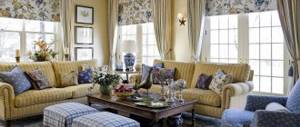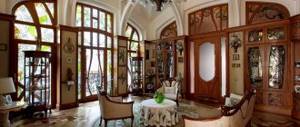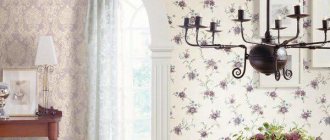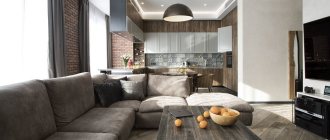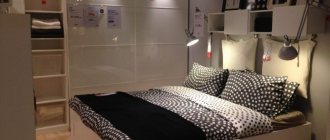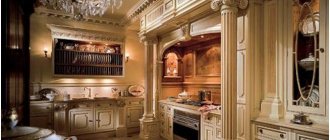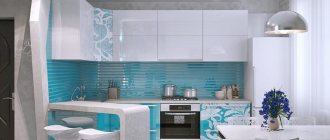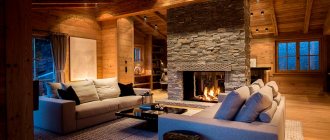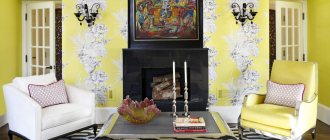Oriental style tiles are an ideal solution when decorating a bathroom interior. It will delight the eye for many years without losing its relevance and special sound. Oriental motifs are always in trend, because the patterns of indescribable beauty are diverse and multi-colored, and the options for their arrangement with each other are limitless. The rooms, designed in the theme of the East, offer amazing harmony and a magical atmosphere in which there is no place for boredom. How to catch fashion trends and where to get ideas?
Features of oriental style tiles
Oriental style tiles are the pinnacle of design, a design that is preferred by people with refined taste and those who seek to emphasize their status. The interior with ceramics decorated with oriental ornaments embodies the centuries-old traditions and rich culture of the East. When you enter it, you feel like a hero of Scheherazade's fairy tales, a padishah, an Indian maharajah and a pharaoh of Egypt.
Ethnic motifs in ceramic tiles are varied and can be made in patterns characteristic of Turkey, Morocco, India, Japan and other Eastern countries. What is oriental style in design? These are rich colors and bright details, plumbing fixtures of non-standard colors or shapes, exclusive furniture upholstery, designer lamps, wood carvings, forged elements and natural stone surfaces.
Oriental ornaments are often dominated by lines and a rich color palette, but designers advise not to overload the interior with patterned elements.
Advice! For example, if the walls and ceiling are lined with patterned tiles, then it is better to let the floor, furniture and decorative elements be neutral without bright accents or detailed details. When the ceiling or walls are neutral, the floors, upholstery, carpets and lamps can be decorated with oriental patterns and motifs.
Basic oriental design styles:
- Iranian or Persian;
- Egyptian;
- Indian;
- Japanese;
- Moroccan;
- Turkish style.
Ceramics in this style accurately imitate the mosaic masonry characteristic of Turkish baths, popular throughout the world. The color palette of ceramics is an abundance of silver, gold and bronze, emerald and purple, ruby, deep blue and emerald highlights.
Tiles are ideal for decorating bathrooms, but if the room is small, do not overload it with ornaments and mosaic decors. It is better to leave the ceiling monochrome, painted in a light color, and decorate the floor and walls with patterns, choosing decor with elements of natural stone and wood.
Room design features
It has characteristic design features that make it difficult to confuse it with another style direction. It is distinguished by:
- Splendor, luxury, abundance of details.
- A large number of interesting patterns, complex ornaments, mosaics.
- Dim, warm lighting.
- An abundance of textile elements, for the creation of which fabrics such as velvet, satin, organza, silk, and brocade are used. You can make textile accessories with your own hands or to order.
- There is a smoothness of the lines, as well as a complete absence of clear geometry. Arched vaults are used to zone the room.
- A special look to the room is given by furniture, which can be represented by low sofas with an abundance of soft pillows, beds with a luxurious canopy, screens, ottomans, and chests. The furniture is heavy, carved and trimmed with semi-precious stones.
- The color scheme of oriental interiors is represented by natural muted shades: terracotta, ocher, beige, sky blue, lilac, crimson, orange, rich green, turquoise, sand. A golden hue is a must in an oriental-style interior. It is presented in abundance in the decor of textile elements.
Zoning
Oriental style decor in the interior is distinguished by some features, in particular, the division of the room into certain areas, each of which is designed to perform certain actions. The most important thing where it is recommended to start the design process is dividing the room into main functional areas. If you plan to equip a large room, then it should be conditionally divided into two main zones:
- recreation;
- eating food.
But if the object is small in size, then these two zones need to be combined with each other. The relaxation area must be equipped with a large and soft sofa with many colorful pillows. A table should be placed in front of it for receiving guests and friends. The eating area should be furnished with an impressive number of ottomans. A low table should be placed in its center.
The main requirement for pieces of furniture is comfort and convenience. Sofas should be upholstered in satin or silk. If desired, instead of colorful upholstery, you can throw a satin blanket on top.
Attention. Instead of a table, you can put a flat chest, which is covered with silk fabric. This move is more preferable for an oriental-style interior.
Finishing walls, floors, ceilings
To decorate the interior, you need to use contrasting colors or, on the contrary, soft pastels. The culture of the East combines the traditions of some countries. They are united by the use of natural raw materials: iron, wood, bamboo.
Usually the walls are finished in a minimalist style. It is characterized by the following shades: sand, cream, cherry, red, brick. All directions are characterized by the use of natural finishing materials.
The flooring can be stone or wood. The universal color of the ceiling is snow-white, but the use of a shade of the walls is allowed.
The Asian direction is characterized by a contrasting finish using beams made of dark wood, which form a rectangular lattice with fairly voluminous cells.
The Arabic style requires smooth forms, as well as exquisite painting. The ceiling can be made multi-level (stretch or suspended). The interior is perfectly emphasized by skillful carvings or overlays with its imitation.
It is recommended to paint the walls with an appropriate coloring composition or cover them with wallpaper with gold ornaments. You can use plain wallpaper in orange, peach, gold, terracotta, wine or brick shades. If you like carpets, you can decorate your interior walls with them.
Furniture
All trends in this style feature only natural furniture. Typically, wood of different species is used for its manufacture. The decoration is carving or inlay with semi-precious stones.
Familiar upholstered furniture is used only in Arabic, Moroccan and Indian styles. But other styles do just fine without it. Only small ottomans and miniature sofas are used there. Great importance is attached to furniture finishing: spectacular upholstery made of natural silk, velvet, brocade, neat embroidery, oriental ornaments.
Furniture in oriental style is always distinguished by its massiveness, naturalness and beauty. The use of plastic or cheap upholstery is unacceptable here: real wood and natural fabrics are the main features of such spectacular furniture.
The wood of furniture must have its natural shade - it is preferable that it be dark. The most important rule in creating an interior in an oriental style is the use of low furniture. It is also desirable that there be little of it. Space is another feature of this style direction.
Decor and accessories
The correct oriental interior is one that contains an abundance of various themed accessories. There should be no random things that act as interior elements. We must not forget that portraits and sculptures are not characteristic of the oriental style. But the abundance of ornaments is welcome here, and they can be depicted on everything. You can decorate tablecloths, carpets, walls, and furnishings with spectacular patterns.
The basic rule is that all ornaments on objects must have the same style. This is the only way to create the right oriental interiors. Particular attention should be paid to carpets made from natural threads, which are valued in the East. If you choose them correctly, you can use several in one room at once: to decorate the floor and walls.
Popular accessories for the room include various openwork lamps, luxurious chandeliers, hookahs, silver and porcelain cutlery. They will only complement the overall design of the room. Floral ornamentation is traditional for dishes in this style. You can also use special bamboo accessories for the room. Textiles occupy an important place in oriental design: lush drapes, rich curtains, expensive tablecloths.
Iranian (Persian) style
Persian, Iranian or Arabic style is a tile where geometric and floral patterns are harmoniously combined. The palette is replete with bright colors: red and azure, burgundy and turquoise, rich green and ultra bright blue.
The general character of the furnishings is emphasized by rich upholstery and luxurious carpets, designer lamps, forged and carved elements. The interior will be complemented by stained glass canvases on the windows, where multi-colored glass casts whimsical multi-colored reflections on everything around.
Design options for various rooms
The diverse culture and rich history of Asia make it possible to find elements of oriental surroundings in modern interiors. Sometimes they are represented by furniture, wall decorations, sometimes the whole room is decorated in the Far Eastern style. Below are some interiors in which the spirit of the East is in the air.
Bathroom
The bathroom, designed in Chinese style, is dominated by the colors of nature and natural materials. There is an exotic tree on the floor and a lot of candles, adding coziness and intimacy. The bathtub has the shape of a circle.
The Eastern style is characterized by wooden windows in an inverted U-shape, usually partially covered with carved bars. Openwork motifs and natural wood furniture are in harmony with the Arabic interior.
Living room interior
The living room pictured below combines Japanese design with modern form. A comfortable European sofa is combined with a low wooden table and cushions as seats. One lamp was replaced by paper lanterns, popular in Asia. The main element of the arrangement is Shoji - a traditional Japanese door in the form of a sliding screen consisting of wooden frames filled with special paper.
Oriental luxury reigns in the living room. The glossy surfaces of the door are covered with gold patterns. An unusually painted mirror frame and heavy furniture made of exotic wood are combined with chrome elements and a modern design. The photo below shows an extraordinary combination of modern elegance with Asian character.
The Japanese style features low-height wooden furniture with simple shapes that work in a minimalist living room. The colors are usually white combined with black, earth tones, with the addition of green, red.
The East in the Indian edition is characterized by a frenzy of energetic colors, patterns, and ornaments. Red, pink, purple, gold are the main colors of the Indian trend. A characteristic pattern associated with Indian aesthetics is paisley, which resembles symmetrically arranged tears.
Bedroom in oriental style
Minimalism and harmony are the quintessence of Japanese art. In the Japanese bedroom shown below, the only decoration is a wooden panel located at the head of the bed in the form of a circle. On the wall hangs a graphic with a shape, a pattern related to the East Asian tradition.
Suitable colors, accessories, decorations will turn the room into a Japanese pagoda or a bedroom from an Indian palace. Japanese style looks especially beautiful in modern apartments.
The base of the bedroom is a low bed. The door of the built-in closet can be styled as a screen, and tatami mats, which are originally made of rice straw, can be placed on the wooden floor.
In the Indian bedroom you will need:
- satin pillows decorated with embroidery, crystals,
- chandelier with beads,
- dark wood furniture, preferably colonial style.
In the oriental style there are:
- elephant figurines,
- brass fittings for cabinets, chairs.
Halfway between Japan and India, there is an Arabic style with muted decorations. The basis of the Arabic style is light colors, broken by gold, bronze, various shades of blue, ideal for the bathroom, bedroom.
Kitchen
Bamboo, popular in Asia, occupies an important place in interiors decorated in oriental style. Bamboo is used for flooring and furniture. The warm tone of the natural exotic material is combined with the raw concrete covering the walls. In the oriental cuisine presented below, tradition is subtly mixed with modernity.
The kitchen and dining room in Indian style can be decorated in lilac tones. The pink wall, patterns, shadows on the floor clearly indicate the East. To create an Indian atmosphere, the room is filled with bright colors:
- pink,
- turquoise,
- red,
- purple.
It is worth purchasing one strong furniture accent - for example, a heavy table - to feel the atmosphere of the fabulous East in your own kitchen or dining room.
It is worth choosing a wooden floor in a warm oriental shade, for example, a fashionable wood from South America - Sucuprie. Its wood is fashionable, hard, moisture-resistant, ideal for kitchens and dining rooms.
Conclusion
Previously, this style was associated with the kitsch of the oriental bazaar. Today its uniqueness is valued - patterns, rich colors, traditional handicrafts. Having decided to use oriental style in your own home, you can try to skillfully insert modern elements. The hot Asian climate, straight out of the story of Scheherizade, with a dash of European chic, looks dazzling.
Egyptian style
The Egyptian style is characterized by an atmosphere of luxury and grandeur, which can be created by a warm color palette and exquisite elements of furniture and decor. When making tiles for walls and floors, designers use the following colors: golden sand, yellow and beige, muted brown, gray and pastel green.
The decor will be complemented by wicker furniture and draped curtains, panels with Egyptian hieroglyphs and drawings, finishing with marble, natural stone and wood. An abundance of architectural elements, such as columns and podiums, gold details in furniture fittings and mirror frames, plumbing fixtures and lamps is welcomed.
Advice! Let the final touch when decorating the interior be figurines of snow leopards and cats, Egyptian vases, pyramids and figurines.
Forged parts and original ornaments
A living room in an oriental style is characterized by unusual patterns, intricate forged items, textile drapery and enchanting carpets, and the furniture is covered with a natural texture.
Design of a combined kitchen-living room: zoning and styles (110 photos)
How to decorate walls inside a house - the best ideas, materials and examples of use with photos
Curtains for the living room - 80 design photos. Recommendations for choosing!
Objects and decoration made of ivory, light silver and bright mother-of-pearl are very appropriate.
In such an interior, you can safely decorate the walls with plaster in a soft sand shade, but accent pieces can be bright textile details that will create a contrast with the calm general background.
The design is complemented by numerous forged lamps.
Indian style
The main features of Indian style are a diverse color palette that creates an atmosphere of luxury and comfort. The tile patterns feature traditional colors: gold, turquoise, burgundy and purple-red.
The overall style is complemented by plumbing fixtures with ornaments and prints, a wooden or mosaic-inlaid floor, bright upholstery, finishing and decorative details made of natural stone and wood.
Accessories
In order for the interior of the apartment to look harmonious, it needs to be thought out in full. In stores you can buy many beautiful oriental-style accessories:
- vases,
- bowls,
- jugs,
- bedspreads,
- figurines,
- candles,
- wall decorations.
Decorations are presented in an eclectic, spontaneous way, like in an oriental market. The stylization is complemented by a play of lights, lamps with crystal icicles, and openwork lanterns with multi-colored glass.
Fiery red color on the walls is a great idea for decorating a bedroom in combination with oriental furniture. An additional effect will be created by aromatic incense, for example, the aroma of sandalwood, soothing, relaxing - fits perfectly into the character of the bedroom.
Bamboo is quite often present in:
- roller blinds,
- photo frames,
- various types of containers,
- screen
The screen is a characteristic element of Japanese interiors.
In every object you can see a person's hand. In the oriental style, traditional handcraft is extremely valued. The interior should feature richly designed metalwork with intricate decorations. The decor is complemented by incense and scented candles.
Japanese style
Japanese interior design is all about natural colors that are combined with laconicism and restrained style in the interior. Ceramic tiles are also dominated by natural shades: beige and brown, muted pink, terracotta and green, white and delicate coffee.
The overall picture is complemented by a recessed bathtub and a floor raised to the level of the sides. The furniture and decoration elements are made of natural materials: silk and wood, bamboo, natural stone, rice paper with origami elements and designs with blossoming sakura branches.
Important! Details characteristic of the Japanese style will help to maintain the style and emphasize the atmosphere of the Land of the Rising Sun. These are bamboo mats and rugs made from natural materials, decorative panels with hieroglyphs, elegant figurines and miniature bonsai trees.
Japanese style in the bathroom
Japanese style in the interior is especially popular due to its functionality. It carries eastern severity, but at the same time lightness and naturalness. If you adhere to traditions, then the main object of the room should be an ofuro - a bathtub made of hanok wood.
You can also use Japanese partitions in the interior. They will help maintain the oriental style and delimit areas for swimming and changing clothes. In decoration it is better to give preference to calm shades. And a variety of modern materials will highlight the originality of the bathroom (for example, ceramic tiles can create the illusion of natural bamboo or wood).
You can also emphasize individuality with the help of lighting - it is better if it is soft and diffused. The walls of such a bathroom can be decorated with hieroglyphs, panels or photos of Japanese beauties.
An unusual bathroom design can add special significance to daily rituals, even simple hygiene procedures. This especially applies to the oriental style, which is more conducive to relaxation than others.
Moroccan style
The decorative design and characteristic features of tiles in this style are rich patterns with geometric outlines and stylized plant and animal motifs, a colorful design in the spirit of Moroccan zelij mosaic. The ceramic patterns accurately imitate zelige tiles, which have been handmade in Morocco for centuries.
Zelig tiles have the following characteristics:
- The color scheme is dominated by neutral, muted tones: pearl and gray, white, bluish, light brown, fawn, gold and lilac;
- The canvas consists of 6x6 cm cubes laid horizontally;
- The mosaic elements fit tightly to each other, while each has its own color and texture and shimmers in the sun with a mother-of-pearl sheen;
- The tiles are diverse and colorful, they harmoniously combine sophistication and simplicity, richness of color, play of contrasts and a clear structure of patterns and motifs.
Oriental-style tiles are used to decorate bathrooms and baths, kitchens and hallways; they are chosen for the design of living spaces, the decoration of stairs and open areas. The magic of the East attracts with the special comfort that it creates in the room. Patterns with plant and animal motifs, an abundance of natural materials and the play of contrasts help to get rid of anxiety and feel the harmony of the world around us.
Chic oriental and Mediterranean charm
The interior of the living room is in an oriental style, in which oriental chic is wonderfully harmonized with the tenderness and charm of the Mediterranean.
The main emphasis of such a room is on the Moroccan flavor, which is diluted with turquoise shades.
The combination of turquoise with terracotta and sandy tones gives an atmosphere of sunshine and a feeling of the seaside.
